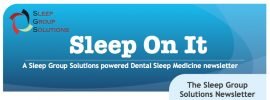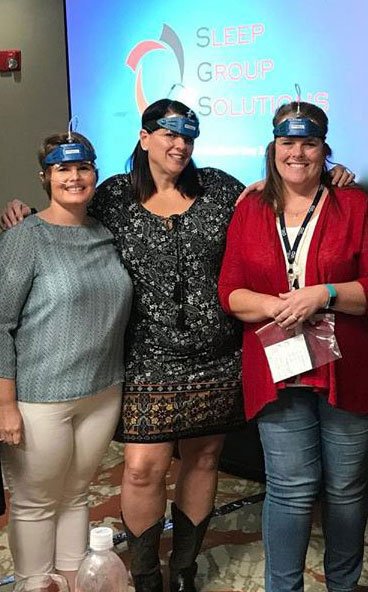
Sleep On It! An SGS Powered Dental Sleep Medicine Newsletter
Enjoy the latest Sleep On It newsletter. For coupons and supporting images, please view and print the PDF from below.
The NHL is on Board with Healthy Sleep Habbits
…and we should be, too!
National Hockey League (NHL) teams are paying closer attention to the quality and quantity of their players’ sleep habits. They learned that healthy sleep can improve their quickness, strength, reaction time and problem solving.
NHL coaches are giving up the traditional early morning skate (practice) so the players can get more pre-game sleep.
During the 2016 Stanley Cup playoffs teams that opted for more sleep are winning more games.
The power of sleep! Are you currently screening all of your patients for snoring and sleep apnea?
A Unique Application of a Mandibular Repositioning Device to Manage Both Temporomandibular Joint Dysfunction and Sleep-Related Breathing Disorders when Co-existing in the Same Patient.
By: Daniel E. Taché, DMD, DABDSM
In an editorial piece which appeared in The Journal of the Craniomandibular Practice and Sleep 2013, Dr. Shapira reminded those of us who treat patients with orofacial pain and temporomandibular joint disorders (TMD) that oftentimes, these patients present to our office with a laundry list of symptoms which are seemingly unrelated to “the jaws and teeth” but often improve from our treatment, most notably symptoms such as:
• Fibromyalgia
• Chronic fatigue syndrome
• Migraine/tension headache syndrome
• Irritable bowel syndrome
• Mitral valve prolapse syndrome
Our understanding of how such conditions might be related has until more recently been poorly understood, (i.e. a medical mystery perhaps). TM disorders have largely been viewed as psycho/social disorders best treated by “psychological therapy and drugs.” These medically unexplained symptoms, are now most often referred to as the Functional Somatic Syndromes.
Because our medical doctors view our treatment of TMD patients as solely orthopedic in nature, there has been a disconnect between medical science and the almost miraculous improvement in the health
of many of our patients. TM disorders have for many years been referred to as The Great Imposter and our treatment protocols were thought of as almost voodoo in nature.
As Dr. Shapira went on to explain, “Sleep is the magic ingredient that explains many of the amazing improvements seen in treated TMD patients.” Undetected and unmanaged sleep disturbances associated with TMJ disorders will often compromise treatment outcomes and reduce the effectiveness of our treatment to reduce these associated symptoms in TMD patients. Sleep disorders
increase systemic inflammation which in turn can adversely affect the cardiovascular system because of the constant cardiac activation occurring during sleep microarousals; these microarousals lead to increased sympathetic dominance of sleep which also been implicated in diabetes and high blood pressure. Newer concepts and techniques for diagnoses and analyses are changing the very nature of how we practice dentistry, which enable us to more fully evaluate and manage our patients. Availing ourselves of current technology and incorporating it into every day protocols of patient assessment will greatly enhance the ability of all dentists to identify patients at risk for sleep-related breathing disorders (SRBD) in our every day practice of Dentistry and because available technology can be delegated to support staff, we can conceivably extend this optimum level of care to every patient we see. Temporomandibular disorders have been linked to sleep disturbances: chief complaints of a majority of TMD patients are unrefreshing sleep
and pain and residual fatigue upon awakening. In several studies, a majority of TMD patients have reported unrefreshing sleep and furthermore that poor sleep quality and symptoms associated with TMD have a bidirectional relationship. Pain-related awakenings from sleep have been shown to have a profound negative effect upon the intensity and severity of masticatory myofascial pain and pain threshold.
A polysomnographic study shows the prevalence of sleep disorders in TMD patients revealed that 45% of the population of patients studied were diagnosed with one sleep disorder and 26% with two sleep disorders.
FULL case review on TheSleepMagazine.com
Whole You and the Respire Medical Devices
Appliance Companies…It’s not about making a quick buck
There are so many options today when selecting an oral appliance. Everyone is competing on design, price, services, added features, etc… Competition is good, but what it really comes down to is, “Who do you want to build a lasting relationship with?”
Which company is going to help drive patients to your practice? Who can help educate the staff to make your life easier? Which company is solely dedicated to OA therapy? Can you pick up the phone and speak to the decision makers within minutes? I can get a device in 48hrs if needed? These are the real questions to ask yourself when selecting an oral appliance company.
In life you will always find someone to make things cheaper, but quality needs to stand above all…both quality of products and service. A few months after we started Respire I received a call from Dr. Howell Goldberg. He asked me why nobody had called him to inquire how his case went. At that moment I realized that relationship building is the underlying factor to building a successful company. Of course now, several years later, I have a team of people working on a very structured client experience process, as we realized competitive pricing is only a small part of becoming successful.
We recently started a large scale patient education program featuring articles in TIME & People magazine, across Pandora radio and working with independent patient groups among others. We had 2 goals here: first was to have patients be more informed about their treatment options and second was to direct these patients to one of our clients who can help relieve the symptoms they are having because of their sleep apnea. We had a huge response and were able to help many patients, but again what we are trying to achieve is more than just selling an appliance. Anyone can do that.
Matching the right device for the right patient takes time to perfect. In October 2015 we released our Endurance Framework (EF) line of devices to address a need in the market. Dentists need something that is very strong, very adjustable, yet as thin as possible. We feel the EF device addresses this need head on. Usually with an acrylic device the acrylic is 1.5-2.5mm thick. With the EF it is almost 0.5 mm around the entire lingual and anterior area, maximizing the tongue space to its fullest. As time moves on we will continue to release new and innovative products into the market, as well as making strides to improve our current designs, thanks in part to our partners at Mitsui Chemicals.
I hope you can join us on this journey. It would be great to continue this discussion in the near future either over the phone or at one of the upcoming trade shows.
David Walton
CEO
The Power of Medical Billing
Dr. Marty Lipsey
You might see the title of this article and think you are going to read about big numbers next to a dollar sign. While that might be the end result of my message, there is much more to it than that.
How important is it to you and your team for your patients to know that you are really going out of your way to help them? I’m hoping you’ll agree that when a patient believes that you are concerned with their financial
welfare as well as their health, you will have a complying patient.
With the Sleep Group Solutions medical billing system you will help your patients give you that “Yes”
Take off your usual hat for a minute and imagine yourself asthe patient…not as the doctor or team member. Imagine yourself walking in to see your new dentist. A friendly and courteous front desk person greets you and welcomes you to the practice. After ashort conversation, you are also welcomed with the following;
“Mr. Patient, we welcome you to our practice and we’d like you to know that we go out of our way for our family of patients. In that effort, aside from your dental insurance card, we’d like to ask you for your medical insurance card. Some of your treatment may be covered by medical insurance. If it is, medical coverage will reduce your out-of-pocket expense and preserve your dental benefits for procedures not covered by your medical insurance.”
What did you just hear? Did you really just hear that this dental practice works with medical insurance? I propose, that as a patient, you’ve heard the power of medical billing in action. I propose you’ve heard that you have walked into the doors of a dental office that’s above and beyond what you might have expected. I propose you’ve heard something that you have never heard at a dental office before today. Most importantly, I propose you might be thinking that you are definitely in the right place!
If you have added sleep medicine or CBCT to your practice, youare missing the power of medical billing unless your team is making this announcement to every one of your patients. Of course you can’t make this announcement unless you can deliver on your promise. The power of medical billing can be harnessed only when your team has mastered successful medical billing protocols or when you’ve partnered with a strategic partner to outsource your medical billing.
Now, please put your regular hat back on and assume your usual role as dentist or dental team member. What else can the power of medical billing mean to you? It can mean that your patients are more open to hearing about their treatment needs instead of missing some of the important details because they are so worried about how much it costs. It might mean that you are truly helping more of your patients to accept more of the treatment they require because your team is able to look into assisting them beyond the paltry limits of their dental insurance. It might mean that you are the dental team that truly is a cut above.
So getting back to my original thought…I hope you’ve realized that the power of medical billing is much more than adding big numbers next to a dollar sign to your practice. I also hope you can see that we certainly can add those big numbers through the power of medical billing.
Instructor Spotlight
Dr. Barry Freydberg
WHY DO WE SCREEN PATIENTS FOR BREATHING DISORDERS?
It’s not all about revenue, or making oral appliances, or hoping they can’t wear their CPAP. It’s much bigger than that!
It’s our responsibility to screen for sleep disorders. We screen our patients because we can … and because we should!
However, the medical education and reimbursement model makes it tough for a PCP to screen for OSA. Most just don’t! Our model permits it. And the specialists, who treat diseases with high co-morbidities with OSA often don’t make the effort it takes to quiz the patient about their sleep issues. And they rarely refer their patients for sleep studies. This is changing, fortunately, but let’s look at an example.
We see the obvious high risk patients all the time. But let’s not miss the 33 years old, 60 inches tall, 100 pounds, BMI 19.4 types!
Phil does not fit our typical pattern of the obvious! He snored and has sinus issues. We sent him for a PSG at a major teaching hospital as he also described leg movement issues and low BMI. The PSG revealed an AHI of 62.35 in REM Supine, 22.45 on his side. He was CPAP intolerant.
Result with a Respire Dorsal Fin appliance and a positional pillow? AHI 5.8, RDI 11.7!
Our remarkable success with Phil going from severe to mild/moderate probably was a result of a combination of factors. And his lack of the many medical issues attributed to OSA was probably due to his age and size. No MD would likely test him. And yes, the sleep doc had treated him for RLS with medication.
The bottom line is….it’s not all about us. Screening will save and improve lives and longevity, and as I say in the seminars, “Sometimes we find patients in a life threating situation and they don’t know it and no one else is helping them”. Even Phil was in a life threatening situation, but his youth and a low BMI masked it.
Yes, I can make money doing sleep appliances and I enjoy doing them and monitoring the wonderful results. But I can also save lives and sometimes not get paid for it. Somehow, I don’t mind the latter.


